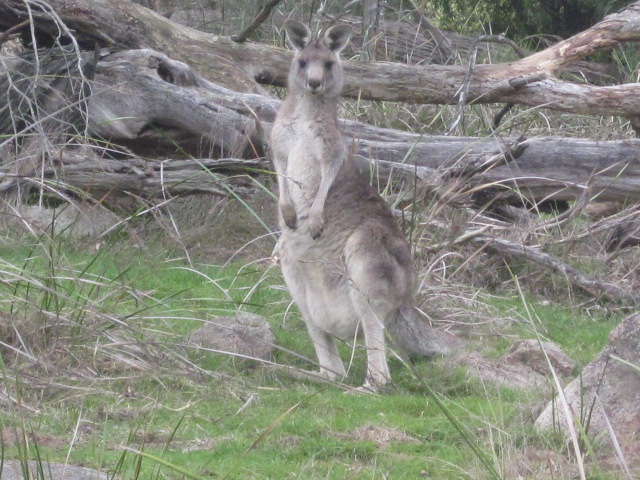Churchill National Park (Rowville)


Churchill National Park at Rowville in Melbourne's south-eastern suburbs is a remnant of natural bush and an example of the original landscape before clearing and settlement. Although most of the park is open regrowth woodland, there are small areas of original forest. Apart from the access road, there are no other vehicle tracks.
Things to Do
- Tracks throughout the park are ideal for peaceful walks. Channel Track, running beside the old aqueduct, wanders through a thickly wooded landscape.
- Some of the tracks are also suitable for jogging and cycling, particularly the eastern boundary track.
- There are plenty of spots for birdwatching. One particularly good one is by a dam along the northern boundary track.
- Picnic grounds are provided at the end of the access road.
Facilities
- Parking, toilets, picnic grounds, shelter, gas barbecues, water, walking tracks and bicycle trails are provided.
Heritage
The area that is now the park was part of the lands of the Bunurong Aboriginal people. Today members of the Wurundjeri community of Melbourne are involved in park management and recovering Aboriginal heritage.
Following the establishment of Melbourne as a European settlement in 1835, the park area became the police corps headquarters for the Native Police in 1837. Later used as grazing land for police horses, it was known for many years as the Police Paddocks.
In the 1920s urban development brought further changes. Local stone was quarried for road metal and building material, a water supply channel was dug to Dandenong and the State Electricity Commission acquired a powerline easement. Fire and clearing of some areas also took their toll.
In 1941 the area was declared Dandenong National Park, and was renamed Churchill (after Sir Winston Churchill) in 1944.
In the 1920s urban development finally brought some changes. Local stone was quarried for road metal and building material, a water supply channel was dug to Dandenong and the State Electricity Commission acquired a powerline easement. Fire and clearing of some areas also took their toll.
In 1941 the area was declared Dandenong National Park, later renamed Churchill National Park (after Sir Winston Churchill) in 1944.
Fauna
Churchill National Park is an especially significant area for an amazing variety of birdlife. A total of 172 species has been recorded in the parks. The birds are attracted by the different types of food and environments; woodlands,forest, the lake and grassy open spaces. Some of these birds include: parrots, honeyeaters, wrens, thornbills, grebes, pelicans,cockatoos and even the migratory Japanese Snipe. Parrots and Bell Miners (commonly know as Bellbirds) are probably the most prominent birds. Take a walk along Bellbird Track and listen to the melodious notes of these birds as they call to other members of their family.
Many of the mammals in the area are active only at night, but if you arrive early or leave at dusk, you may catch a glimpse of a wallaby or kangaroo. Echidnas are also common, foraging around in the daytime looking for ants and grubs in the ground and under the bark of trees. In the Summer Green and Golden Bell-frogs may be found basking in the sun.
Vegetation
Plant life includes 20 different eucalypt species, 14 wattles and 12 native orchids. Wildflowers are abundant in spring. The park is an excellent place to learn how to distinguish some of the common eucalypts and wattles of the Melbourne area.
Looking After the Park
- Please take your rubbish with you.
- No dogs, cats or firearms.
- No solid fuel fires.
- Leave the park as you find it.
How to Get There
Churchill National Park can be accessed by driving along Churchill Park Drive, Rowville and continuing to the main gate about 1 km after the Power Road turn-off.
Opening Hours:
Churchill National Park is open every day of the year. The park opens at 10:00 AM every day, but closing times vary according to daylight savings. For up to date information on park closing times call the Parks Victoria Information Centre on 13 1963.
Access for Dogs:
Dogs and other pets are not permitted in the park.
Review:
The picnic area has a very large shelter with seven tables, BBQ, toilet and water tap (non drinking water). There is also a grassy area with some unshaded tables. From the picnic area is a 320m return walk which passes through a range of vegetation but the view is spoilt by the sight of huge electricity pylons.
If you venture out of this area it is best to take a map (even the page from Melways is enough). A number of damaged or missing road signs make route navigation trickier than it should have to be. The main tracks are gravel with little rocks on the surface and there a quite a few big hills. We saw a mob of kangaroos south of the quarry along Stonemason's Track - so keep your eyes open, especially along Kangaroo Track. There might be a reason why it is called Kangaroo Track! The lagoon in the south east had frogs but the tea-trees were growing in the water and this made access difficult. The old quarries are quite small but give a feel for how provided stone in the past. There is an access path to Lysterfield Lake via Lysterfield Hills track (7.2 km). Be wary of closing time for the park since it was quite early.
Photos:
Location
Churchill Park Drive, Rowville 3178 View Map
Web Links
→ Churchill National Park (Parks Victoria)
→ Churchill National Park & Lysterfield Park - Visitor Guide








